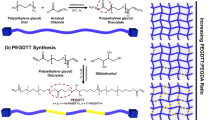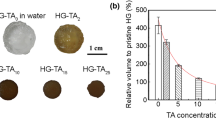Abstract
Polygalacturonic acid (PGA) hydrogel cross-linked via disulfide bonds was synthesized using a thiol oxidation reaction. PGA was grafted with cysteine to yield thiolated PGA (denoted PGAcys). Per gram, PGA-conjugated cysteine was 725 ± 77 μmol, and the degree of modification was 16.24 %. A PGAcys hydrogel film was fabricated under physiological conditions, with gel content 91.6 % and water content 43.3 %. The PGAcys hydrogel was used as a drug carrier for rosmarinic acid (RA) (denoted PGAcys/RA) and to prevent postsurgical adhesion. The in vitro dynamic release behavior of RA from the PGAcys hydrogel was analyzed. The profiles showed that 80 % of the total RA was released from the hydrogel within 15 min, followed by zero-order kinetic release. Animal implant studies showed that PGAcys and PGAcys/RA hydrogel films reduced adhesion incidence by over 90 %, significantly higher than did Hyaluronate/Carboxymethylcellulose (analogous Seprafilm™) (42 %). The PGAcys/RA hydrogel film also reduced the early inflammatory reaction.





Similar content being viewed by others
References
Ralet MC, Dronnet V, Buchholt HC, Thibault JF. Enzymatically and chemically de-esterified lime pectins: characterisation, polyelectrolyte behaviour and calcium binding properties. Carbohydr Res. 2001;336(2):117–25.
Daas PJH, Boxma B, Hopman AMCP, Voragen AGJ, Schols HA. Nonesterified galacturonic acid sequence homology of pectins. Biopolymers. 2001;58(1):1–8.
Musabayane CT, Munjeri O, Matavire TP. Transdermal delivery of chloroquine by amidated pectin hydrogel matrix patch in the rat. Ren Fail. 2003;25(4):525–34.
Sande SA. Pectin-based oral drug delivery to the colon. Expert Opin Drug Deliv. 2005;2(3):441–50.
Cipriani TR, Mellinger CG, de Souza LM, et al. Polygalacturonic acid: another anti-ulcer polysaccharide from the medicinal plant Maytenus ilicifolia. Carbohydr Polym. 2009;78(2):361–3.
Westwood M, Noel TR, Parker R. Environmental responsiveness of polygalacturonic acid-based multilayers to variation of pH. Biomacromolecules. 2011;12(2):359–69.
Lee MW, Hung CL, Cheng JC, Wang YJ. A new anti-adhesion film synthesized from polygalacturonic acid with 1-ethyl-3-(3-dimethylaminopropyl)carbodiimide crosslinker. Biomaterials. 2005;26(18):3793–9.
Powell HM, Boyce ST. EDC cross-linking improves skin substitute strength and stability. Biomaterials. 2006;27(34):5821–7.
Shu XZ, Liu Y, Luo Y, Roberts MC, Prestwich GD. Disulfide cross-linked hyaluronan hydrogels. Biomacromolecules. 2002;3(6):1304–11.
Shahnaz G, Perera G, Sakloetsakun D, Rahmat D, Bernkop-Schnürch A. Synthesis, characterization, mucoadhesion and biocompatibility of thiolated carboxymethyl dextran-cysteine conjugate. J Control Release. 2010;144(1):32–8.
Rahmat D, Sakloetsakun D, Shahnaz G, Perera G, Kaindl R, Bernkop-Schnürch A. Design and synthesis of a novel cationic thiolated polymer. Int J Pharm. 2011;411(1–2):10–7.
Shu XZ, Liu Y, Palumbo F, Prestwich GD. Disulfide-crosslinked hyaluronan-gelatin hydrogel films: a covalent mimic of the extracellular matrix for in vitro cell growth. Biomaterials. 2003;24(21):3825–34.
Liu Y, Skardal A, Shu XZ, Prestwich GD. Prevention of peritendinous adhesions using a hyaluronan-derived hydrogel film following partial-thickness flexor tendon injury. J Orthop Res. 2008;26(4):562–9.
Bernkop-Schnürch A, Kast CE, Richter MF. Improvement in the mucoadhesive properties of alginate by the covalent attachment of cysteine. J Control Release. 2001;71(3):277–85.
Bernkop-Schnürch A, Schwarz V, Steininger S. Polymers with thiol groups: a new generation of mucoadhesive polymers? Pharm Res. 1999;16(6):876–81.
Riddles PW, Blakeley RL, Zerner B. Reassessment of Ellman’s reagent. Methods Enzymol. 1983;91:49–60.
Rodrigues LB, Leite HF, Yoshida MI, Saliba JB, Junior ASC, Faraco AAG. In vitro release and characterization of chitosan films as dexamethasone carrier. Int J Pharm. 2009;368(1–2):1–6.
Zhang R, Huang Z, Xue M, Yang J, Tan T. Detailed characterization of an injectable hyaluronic acid-polyaspartylhydrazide hydrogel for protein delivery. Carbohydr Polym. 2011;85(4):717–25.
Yoo SH, Fishman ML, Savary BJ, Hotchkiss AT. Monovalent salt-induced gelation of enzymatically deesterified pectin. J Agric Food Chem. 2003;51(25):7410–7.
McKenna BA, Nicholson TM, Wehr JB, Menzies NW. Effects of Ca, Cu, Al and La on pectin gel strength: implications for plant cell walls. Carbohydr Res. 2010;345(9):1174–9.
Matricardi P, Dentini M, Crescezi V, Ross-Murphy SB. Gelation of chemically cross-linked polygalacturonic acid derivatives. Carbohydr Polym. 1995;27(3):215–20.
Marschütz MK, Bernkop-Schnürch A. Thiolated polymers: self-crosslinking properties of thiolated 450 kDa poly(acrylic acid) and their influence on mucoadhesion. Eur J Pharm Sci. 2002;15(4):387–94.
Kafedjiiski K, Jetti RKR, Föger F, et al. Synthesis and in vitro evaluation of thiolated hyaluronic acid for mucoadhesive drug delivery. Int J Pharm. 2007;343(1–2):48–58.
Harris ES, Morgan RF, Rodeheaver GT. Analysis of the kinetics of peritoneal adhesion formation in the rat and evaluation of potential antiadhesive agents. Surgery. 1995;117(6):663–9.
Huang X, Brazel CS. On the importance and mechanisms of burst release in matrix-controlled drug delivery systems. J Control Release. 2001;73(2–3):121–36.
Brochhausen C, Schmitt VH, Rajab TK, et al. Intraperitoneal adhesions—an ongoing challenge between biomedical engineering and the life sciences. J Biomed Mater Res A. 2011;98A(1):143–56.
Parnham MJ, Kesselring K. Rosmarinic acid. Drug Future. 1985;10:756–7.
Cheong YC, Laird SM, Li TC, Shelton JB, Ledger WL, Cooke ID. Peritoneal healing and adhesion formation/reformation. Hum Reprod Update. 2001;7(6):556–66.
diZerega GS, Campeau JD. Peritoneal repair and post-surgical adhesion formation. Hum Reprod Update. 2001;7(6):547–55.
Zdařilová A, Svobodová A, Šimánek V, Ulrichová J. Prunella vulgaris extract and rosmarinic acid suppress lipopolysaccharide-induced alteration in human gingival fibroblasts. Toxicol Vitro. 2009;23(3):386–92.
Huang N, Hauck C, Yum MY, et al. Rosmarinic acid in Prunella vulgaris ethanol extract inhibits lipopolysaccharide-induced prostaglandin E2 and nitric oxide in RAW 264.7 mouse macrophages. J Agric Food Chem. 2009;57(22):10579–89.
Huang SS, Zheng RL. Rosmarinic acid inhibits angiogenesis and its mechanism of action in vitro. Cancer Lett. 2006;239(2):271–80.
Acknowledgments
This research was supported in part by a Grant from National Science Council, Republic of China (NSC 98-2221-E-010-001-MY3).
Author information
Authors and Affiliations
Corresponding author
Rights and permissions
About this article
Cite this article
Peng, HH., Chen, YM., Lee, CI. et al. Synthesis of a disulfide cross-linked polygalacturonic acid hydrogel for biomedical applications. J Mater Sci: Mater Med 24, 1375–1382 (2013). https://doi.org/10.1007/s10856-013-4901-x
Received:
Accepted:
Published:
Issue Date:
DOI: https://doi.org/10.1007/s10856-013-4901-x




